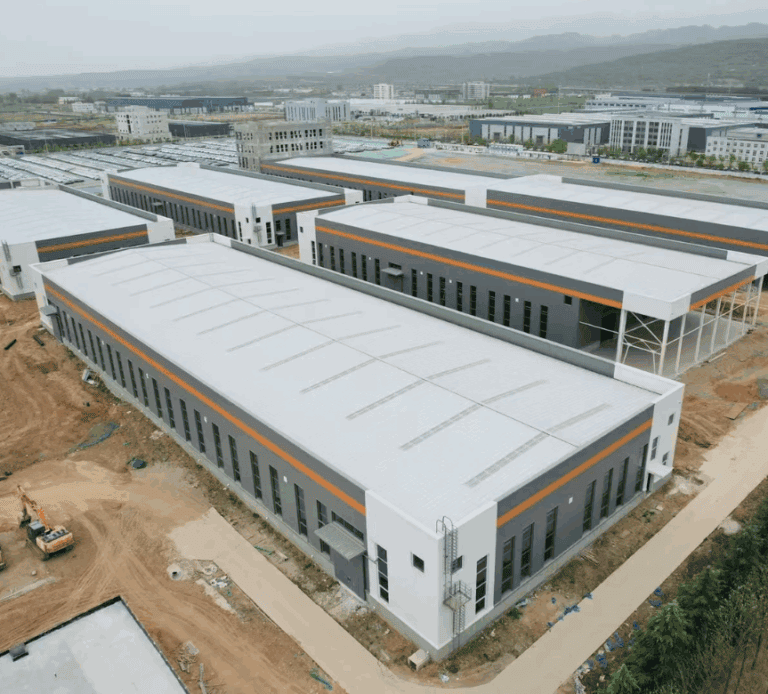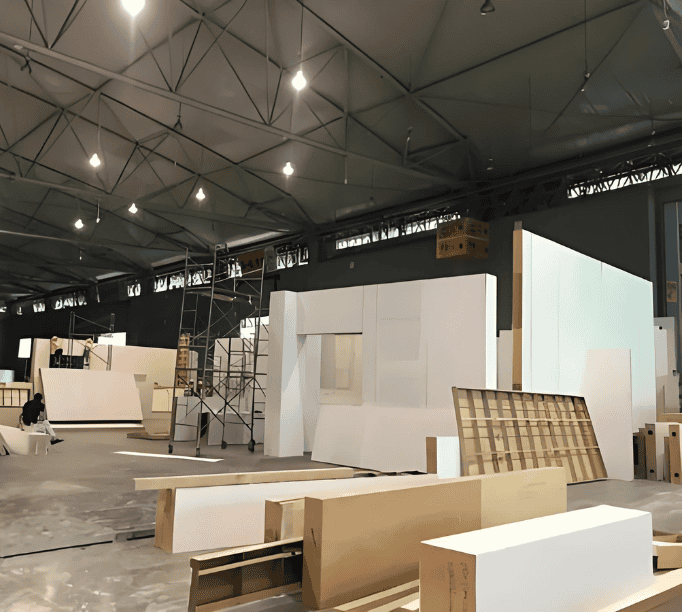Quizás estés cansado de las casas caras. Quizás sueñas con vivir en tu propio terreno: algo sencillo, eficiente y tuyo.
Has oído que las casas modulares son más rápidas, más inteligentes y más económicas. Pero ¿por dónde empezar? ¿Se puede simplemente comprar un terreno y construir una casa en él? ¿Qué hay de la zonificación, los cimientos y los servicios públicos?
Esta guía te guía paso a paso. Sin rodeos ni confusiones: un camino claro desde el "qué pasaría si..." hasta la "preparación para la mudanza".
Empecemos.
Qué esperar en este blog:
¿Es realmente posible construir una casa modular en un terreno comprado?
Sí, pero no cualquier tierra y no sin un plan.
Las casas modulares se construyen en una fábrica, luego se transportan e instalan en el lugar. Una vez colocadas sobre una base permanente, se consideran bienes inmuebles, al igual que las casas tradicionales en la mayoría de los estados. Esto significa Construyendo una casa modular en un terreno Ser propietario es absolutamente posible, pero solo si el terreno es adecuado. Antes de imaginar su futura casa en una parcela tranquila, primero debe verificar dos aspectos: la zonificación y la normativa de uso del suelo.
Leyes de zonificación Decida qué tipo de estructura puede colocar en un terreno específico. Algunas zonas permiten casas modulares por defecto, mientras que otras pueden restringirlas, especialmente si la propiedad está zonificada para agricultura o se encuentra en una comunidad con regulaciones estrictas. Por ejemplo, puede encontrarse con Zonificación R2 al buscar terreno. El Significado de la zonificación R2 Generalmente se refiere a áreas diseñadas para uso residencial bifamiliar, como dúplex, pero en muchos condados también permite viviendas modulares unifamiliares. Siempre contacte con la oficina de zonificación o el departamento de planificación local antes de comprar y pregunte directamente: ¿Puedo comprar un terreno y construir allí una casa modular?
Normas de uso del suelo También puede afectar:
- Requisitos mínimos de tamaño de la vivienda
- Si necesita un tipo específico de base
- ¿A qué distancia debe estar su casa de la carretera o del límite de la propiedad?
A medida que busques, también verás opciones como casas prefabricadas en venta, casas pequeñas en venta, o incluso un Casa móvil en venta en terreno privadoSi bien estas pueden ser atractivas, recuerde que las casas modulares son diferentes: cumplen con los mismos códigos de construcción que las casas prefabricadas, lo que facilita su financiación y las hace más seguras para una inversión a largo plazo. Las casas prefabricadas o minicasas pueden regirse por códigos diferentes, y las casas móviles suelen tener restricciones de zonificación o reventa más estrictas.
No confíe en la palabra del vendedor ni en un anuncio en línea. Los problemas legales con el terreno pueden retrasar o bloquear todo su proyecto.
En resumen: Sí, puedes construir una casa modular en un terreno que compres, siempre que la propiedad esté zonificada para ello y cumpla con todas las normativas locales. Empieza con las autoridades locales. Es el primer paso más importante.
¿Qué tipo de terreno puedes utilizar?
No todos los terrenos están preparados para una casa modular, o incluso no son legales para construirla.
El terreno residencial suele ser la opción más segura
Si una propiedad ya está zonificada para uso residencial, la colocación de una casa modular suele ser sencilla. Estas parcelas están destinadas a viviendas, y las autoridades locales están acostumbradas a tramitar permisos para viviendas unifamiliares, incluidas las modulares. Aun así, siempre verifique las restricciones, como el mínimo de metros cuadrados o los códigos de diseño específicos.
Algunos constructores también ofrecen ofertas de paquetes de terrenos, donde la financiación del terreno y la vivienda se agrupan. Esto puede facilitar considerablemente el proceso de adquisición de una propiedad, especialmente si desea evitar la gestión de múltiples préstamos.
La tierra “sin restricciones” no siempre está libre de problemas
Es posible que vea anuncios de "terrenos sin restricciones" y asuma que eso significa libertad total. En realidad, el término es vago y a menudo se malinterpreta. Generalmente significa que no hay restricciones de subdivisión, pero las leyes locales de zonificación y los códigos de construcción aún se aplican. Algunos condados permiten casas prefabricadas en terrenos sin restricciones, otros no. Confirme con el condado antes de comprometerse.
A veces incluso puedes ver Casas ya construidas para poner en terreno Se comercializan como una opción sencilla. Si bien esto puede ahorrar tiempo, siempre verifique si la zonificación, los servicios públicos y los cimientos están legalmente aprobados para la instalación modular.
Las tierras agrícolas o rurales pueden ser complicadas
Sí, a veces se pueden construir casas modulares en parcelas agrícolas, especialmente en zonas rurales con zonificación flexible. Pero deberá verificar:
- Si se permiten estructuras residenciales
- Si hay acceso a servicios públicos (o espacio para sistemas fuera de la red)
- Si necesita infraestructura adicional como caminos privados o pozos
Y si bien es posible que encuentre listados de un Casa móvil en venta en terreno privadoRecuerde que las casas modulares reciben un trato diferente. Se construyen con los mismos estándares que las casas prefabricadas, lo que las convierte en una inversión a largo plazo más sólida en comparación con las casas móviles, que pueden estar sujetas a mayores restricciones de zonificación.
Aspectos clave a tener en cuenta antes de elegir cualquier parcela
- Clasificación de zonificación: ¿Está permitido el uso residencial?
- Acceso por carretera: ¿Puede un camión de reparto llegar al lugar?
- Suelo y pendiente: ¿Es el terreno lo suficientemente estable para una cimentación?
- Utilidades: ¿Hay electricidad, agua y alcantarillado disponibles o posibles?
Antes de comprar: Piense más allá del anuncio
Una trama que parece buena en línea podría no funcionar en la realidad. Pregúntate siempre:
¿Puedo construir aquí legalmente? ¿Será habitable la casa una vez instalada?
Comience con la oficina de planificación de su condado. Una llamada de 10 minutos puede ahorrarle meses de dolores de cabeza.
¿Cuál es el proceso de compra de terreno para una casa modular?
Comprender cómo comprar un terreno y construir una casa modular es fundamental para una experiencia fluida. Ya sea que busque "casas prefabricadas en Alabama", "casas prefabricadas en San Antonio" o "cómo comprar una casa modular y un terreno" en otra región, trabaje siempre con distribuidores de confianza que conozcan las particularidades locales de zonificación y financiamiento. Esto le ayudará a navegar el proceso y evitar obstáculos ocultos.
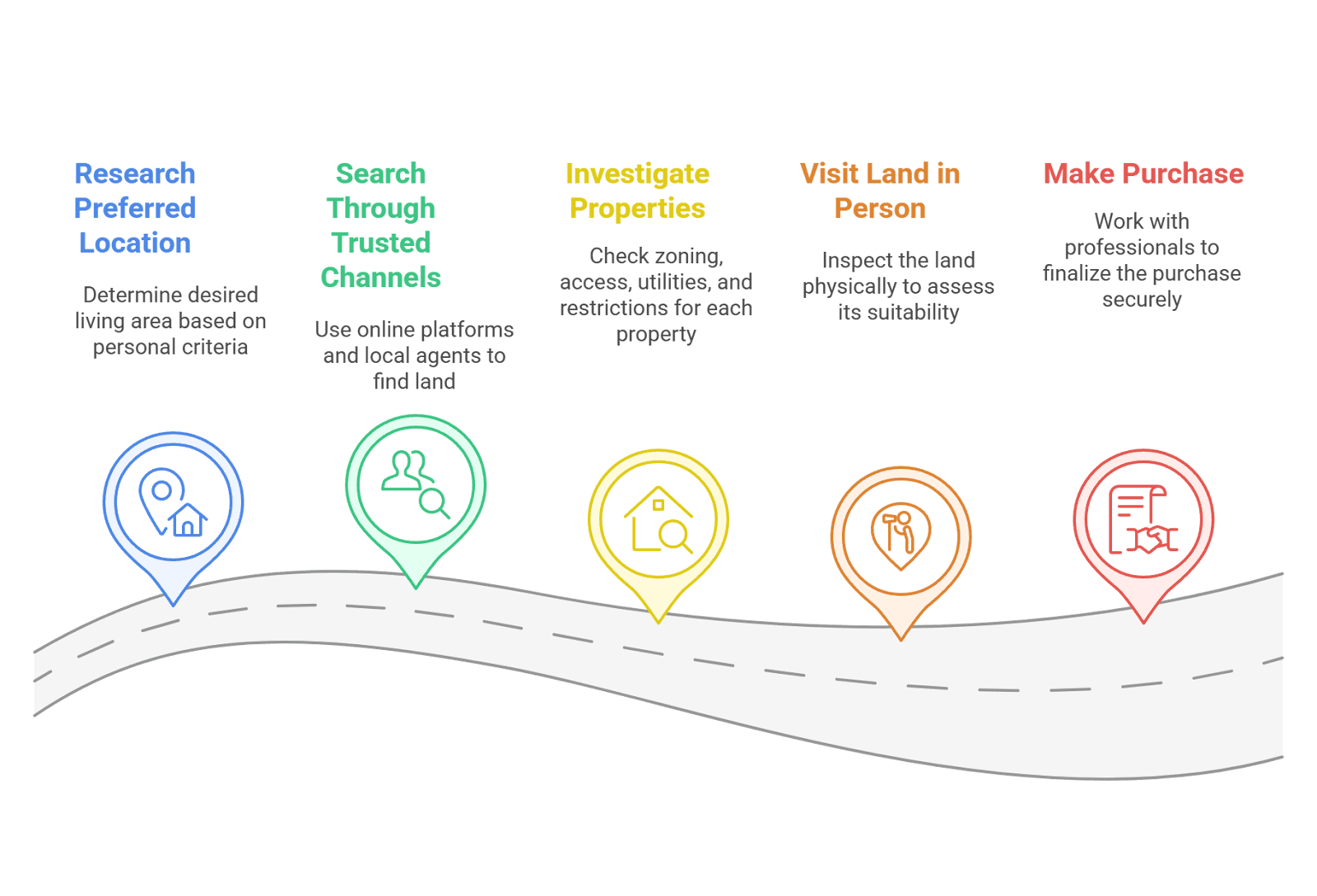
Empieza por investigar dónde quieres vivir
Antes de buscar parcelas específicas, defina su ubicación preferida. Considere el trayecto, el acceso a servicios, la cobertura de internet, las zonas escolares o si planea vivir fuera de la red eléctrica. Algunos condados son mucho más favorables para las casas modulares que otros.
Busque a través de canales confiables
Puedes usar plataformas como Zillow, LandWatch o Realtor.com, pero no te quedes ahí. Habla con agentes inmobiliarios locales, especialmente con aquellos que conocen terrenos rurales o no urbanizados. Suelen estar al tanto de las parcelas fuera de mercado y las peculiaridades de la zonificación.
Haga su tarea sobre cada propiedad
Una vez que encuentre una parcela que le guste, tómese un momento antes de llamar al vendedor. Verifique:
- Normas de zonificación y uso del suelo (con el condado)
- Acceso a la parcela: ¿Existe un camino legal?
- Disponibilidad de servicios públicos o viabilidad de instalación
- Cualquier restricción o servidumbre de la Asociación de Propietarios
No quieres firmar un contrato solo para descubrir que no hay ninguna línea eléctrica cerca o, peor aún, que no puedes construir en absoluto.
Visita el terreno en persona
Las imágenes rara vez cuentan la historia completa. Recorra el sitio. Observe la pendiente, el drenaje, las estructuras cercanas y el acceso por carretera. Si es posible, lleve consigo a un contratista o constructor de módulos. Una visita rápida al sitio puede revelar con anticipación los puntos críticos.
Haz la compra, pero protégete
Una vez que esté listo para comprar, trabaje con un agente inmobiliario o un abogado para revisar el contrato. Asegúrese de incluir un período de diligencia debida en el acuerdo, dándole tiempo para confirmar todas las condiciones legales y técnicas antes del cierre.
Puedes pagar en efectivo si puedes o explorar préstamos de terrenos. Solo ten en cuenta que préstamos solo para tierras A menudo se requieren pagos iniciales más altos y las condiciones son más estrictas. Algunos constructores modulares se asocian con prestamistas que ofrecen financiación combinada de terreno y vivienda; conviene preguntar con antelación.
No importa cuántas ganas tengas de avanzar, tómate tu tiempo. Comprar el terreno equivocado es uno de los errores más costosos en los proyectos de casas modulares, pero el terreno adecuado lo facilita todo.
¿Qué permisos y aprobaciones necesita?
Probablemente no quieras lidiar con permisos; la mayoría de la gente no lo hace. Pero si vas a construir una casa modular en un terreno, Los permisos no son opcionalesSon los que hacen que el proyecto sea legal, seguro y asegurable. Omitir este paso podría acarrear retrasos graves o incluso un desmontaje forzoso posterior.
¿La buena noticia? La lista de aprobaciones suele ser clara y, en muchos casos, tu constructor puede ayudarte con la mayor parte. Pero aun así, necesitas entender qué se requiere y cuándo actuar para que nada se atasque más adelante.
¿Necesita un permiso para colocar una casa modular en su terreno?
En casi todos los casos, sí. Al igual que con una casa tradicional, necesitarás una permiso de construcción Antes de instalar una casa modular, asegúrese de que su casa cumpla con los códigos locales de seguridad, zonificación y estructura. Si su casa se va a construir sobre una base permanente, los permisos suelen ser innegociables.
¿Quién emite los permisos?
Por lo general, es tu departamento de construcción del condado o de la ciudadDependiendo de dónde viva, también podrían involucrar a los departamentos de salud (para sistemas sépticos) o a las autoridades de servicios públicos. Una llamada rápida a la oficina local le dirá exactamente quién se encarga de qué.
¿Qué tipos de aprobaciones están involucradas?
Puede variar según la ubicación, pero la mayoría de los proyectos requieren:
- Permiso de construcción (para aprobar la estructura)
- Permiso de fundación (si es vertido o basado en muelle)
- Permisos de conexión de servicios públicos (para electricidad, agua, fosa séptica/alcantarillado)
- Permisos de entrada o acceso (si está agregando o utilizando un camino privado)
En zonas rurales o sin zonificación, este proceso puede ser más sencillo, pero nunca lo omita. Incluso en zonas con baja regulación, no obtener los permisos puede causar problemas con el seguro o la reventa posteriormente.
¿Su constructor le ayudará con el proceso?
A menudo, sí. Muchos constructores de casas modulares gestionan los permisos como parte de un... servicio llave en manoPero no todos lo hacen. Siempre pregunte esto al principio de la conversación. Si no lo cubren, tendrá que gestionar el papeleo usted mismo o contratar a un gestor de permisos para que le ayude.
¿Cuando debes empezar a aplicar?
Inmediatamente después de comprar el terreno y finalizar los planos de su casa. No espere. Los permisos pueden tardar. semanas a meses, especialmente en condados con mucha actividad o zonas con procesos de revisión estrictos. Cuanto antes empiece, menos sorpresas tendrá más adelante.
¿Cómo se prepara el terreno antes de la instalación?
Una vez que tengas los permisos, es hora de preparar el terreno. Piensa en esta fase como la conversión de un terreno sin edificar en un sitio edificable. Todo lo que ocurra aquí afectará la fluidez, o la complejidad, de la instalación.
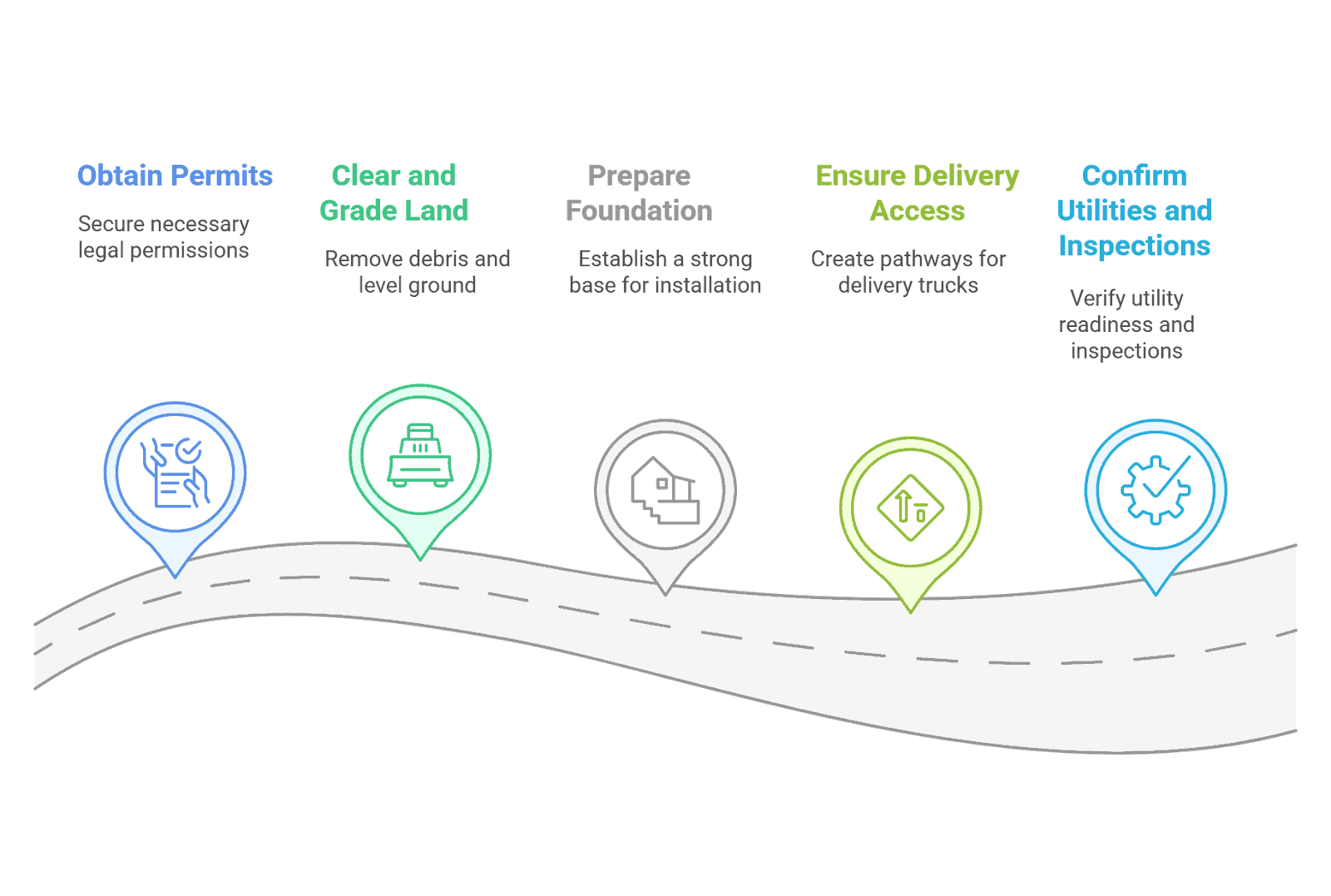
Primero, limpie y nivele el terreno.
Deberá retirar árboles, maleza, rocas y cualquier residuo del área de construcción. Incluso los terrenos relativamente planos suelen necesitar nivelación. El objetivo es crear una superficie sólida y nivelada donde se puedan colocar los cimientos.
Si el terreno tiene pendiente, la nivelación puede implicar excavar la colina o construir en zonas bajas. Un contratista local o un equipo de preparación del terreno pueden guiarle; rara vez es un trabajo que pueda hacer usted mismo.
A continuación, prepara la base.
Las casas modulares necesitan una base sólida y nivelada. Por lo general, esta será:
- Una losa de hormigón vertido
- Un espacio de acceso con paredes de bloques o pilares
- Un sótano completo
Su constructor a menudo le ayudará a coordinar esto, pero el trabajo suele ser realizado por un contratista local de cimentación. Es posible que necesite una inspección antes y después del vertido, dependiendo de su condado.
No olvides el acceso para la entrega
Las casas modulares se entregan en secciones grandes y necesitan espacio. Esto significa:
- Un camino o entrada lo suficientemente ancho para camiones de reparto.
- Un camino claro sin árboles que sobresalgan ni curvas cerradas.
- Una zona de apoyo plana para la grúa (si se utiliza)
Esta parte suele pasarse por alto y es una de las causas más comunes de retraso. Pida a su constructor que le acompañe a recorrer la obra e identifique con antelación cualquier problema de acceso.
Por último, confirme los servicios públicos y las inspecciones del sitio.
Antes de la instalación, asegúrese de que el agua, la electricidad y el alcantarillado estén listos o programados. En algunos casos, la energía eléctrica temporal podría ser suficiente en esta etapa. Además, confirme si el condado requiere una inspección previa a la instalación una vez finalizadas las obras.
La preparación del terreno no es la parte más llamativa del proyecto, pero es lo que hace posible el resto. Un poco de planificación le ahorrará tiempo, dinero y estrés cuando finalmente llegue la casa.
¿Cómo se conectan los servicios públicos a una casa modular?
Tienes el terreno, los permisos y una fecha de entrega, pero ¿es tu casa realmente habitable? Eso depende de la correcta instalación de tus servicios públicos. Tanto si te desconectas de la red eléctrica como si te conectas a los sistemas de la ciudad, esto es lo que necesitas saber.
Agua: ¿de pozo o de suministro urbano?
Si su terreno se encuentra en una zona urbanizada, la conexión a una red municipal de agua suele ser la opción más sencilla. Un fontanero suele tender una línea desde el contador hasta su casa, y usted pagará las tarifas de conexión a la ciudad o al condado.
En zonas rurales, podría ser necesario perforar un pozo. Esto implica contratar a un perforador de pozos con licencia, analizar la calidad del agua e instalar un tanque de presión. No es barato, pero en algunas zonas es la única opción. Asegúrese de que su terreno tenga suficiente espacio para un pozo y un sistema séptico; deben estar separados por cierta distancia.
Electricidad: acceso a la red o energía alternativa
Si hay una línea eléctrica cercana, su compañía eléctrica local puede extender el servicio a su propiedad. Esto suele implicar la instalación de un nuevo medidor y una línea de servicio subterránea (o aérea). También necesitará instalar un panel de interruptores en la vivienda.
¿No tienes red eléctrica cerca? Puedes explorar opciones fuera de la red, como la energía solar; solo sé realista. Que una casa modular funcione a tiempo completo con energía solar requiere baterías, generadores de emergencia y una planificación energética minuciosa. Para la mayoría de los propietarios, la red eléctrica sigue siendo la opción más práctica.
Alcantarillado: ¿séptico o alcantarillado urbano?
En pueblos y suburbios, es posible conectarse al sistema de alcantarillado municipal. Sin embargo, en zonas rurales, casi siempre se requiere un sistema séptico.
La instalación de un sistema séptico implica:
- Una prueba de percolación (perc) para comprobar el drenaje del suelo.
- Aprobación del condado del diseño de su sistema
- Excavación profesional e instalación de tanques.
Esta parte puede tardar varias semanas, especialmente si los permisos son lentos o el suelo no drena bien. Empiece pronto y trabaje con un contratista autorizado.
Su casa modular podría entregarse en semanas, pero hacerla habitable requiere una planificación inteligente de los servicios públicos. Consulte con su constructor desde el principio: ¿Qué servicios públicos están incluidos y cuáles debo gestionar yo mismo? Tener respuestas claras ahora hará que el día de la mudanza sea mucho más sencillo.
¿Cuánto cuesta preparar un terreno para una casa modular?
No existe una cifra única que se aplique a todos los proyectos de casas modulares, y eso es lo que dificulta la elaboración de presupuestos. Pero con el desglose correcto, puedes empezar a elaborar un plan de costos realista y evitar sorpresas.
Tierra
Los precios varían mucho según la ubicación, el acceso y la infraestructura.
- Una parcela rural podría costar entre $10,000 y $50,000
- Los terrenos suburbanos pueden variar desde $50,000 hasta más de $150,000
- No olvide los costos de cierre, las inspecciones y los honorarios legales (que suelen ser entre 1TP y 1T1,000 y 3,000 adicionales).
Para los compradores con presupuesto limitado, algunos mercados ofrecen excelentes puntos de entrada. Por ejemplo, a menudo verá anuncios de... Casas prefabricadas por menos de $100k en Maine Los residentes las consideran opciones de vivienda asequibles, especialmente cuando se combinan con parcelas rurales más pequeñas.
Preparación del sitio y cimentación
Preparar el terreno e instalar los cimientos añade un coste significativo.
- Desmonte y nivelación de terrenos: $2,000–$10,000
- Cimentación (losa, espacio de acceso o sótano): $10,000–$30,000+
- Camino de acceso, acceso con grúa, control de erosión: depende de la complejidad del sitio
La casa modular en sí
Los precios base de las casas modulares varían entre $80 a $150 por pie cuadrado, dependiendo del tamaño, acabados y personalización.
- Una casa sencilla de 111,5 m² podría costar alrededor de 100.000 T/T.
- Los complementos como terrazas, porches y cocinas renovadas pueden aumentar el precio rápidamente.
Si busca ahorrar aún más costos, navegue casas modulares usadas en venta Puede ser una forma inteligente de reducir el gasto inicial. Estas opciones de segunda mano pueden costar una fracción del costo de las casas nuevas, aunque deberá considerar el transporte, la renovación y el cumplimiento de las normativas locales.
Conexiones de servicios públicos
Si está fuera de la red o en un terreno baldío, los servicios públicos pueden ser un factor importante.
- Perforación de pozos: $5,000–$15,000
- Sistema séptico: $3,000–$10,000+
- Instalación eléctrica: $2,000–$10,000 dependiendo de la distancia y el acceso
Costos ocultos comunes a tener en cuenta
Algunos gastos no aparecen en la primera cotización, pero son importantes:
- Tarifas de permisos
- Energía temporal durante la construcción
- Tarifas adicionales de transporte o grúa si el acceso es difícil
- Problemas del suelo que requieren renivelación o ingeniería
- Retrasos (mal tiempo, retrasos en los permisos, etc.)
Planificar con un presupuesto completo te ayuda a mantener el control. No se trata solo de la casa, sino también del terreno, la distribución y todo lo demás. Un presupuesto inteligente te da un margen de maniobra. Si te preparas para lo inesperado, rara vez te sorprenderá.
¿Es posible financiar un terreno y una casa modular juntos?
Sí, pero depende de cómo estructure el trato y del prestamista que elija.
Financiamiento de una casa modular No es exactamente lo mismo que financiar una construcción tradicional. Los prestamistas evalúan los terrenos de forma diferente, y algunos no ofrecen préstamos para viviendas que aún no están construidas. Pero aún tiene opciones. La clave es comprender qué tipo de préstamo se adapta a su situación, ya sea que esté explorando... ofertas de paquetes de terrenos, o trabajando en Financiamiento de una casa modular en terreno propio.
Opción 1: Préstamo de terreno + préstamo de construcción
Si primero va a comprar un terreno, podría empezar con un préstamo inmobiliario. Estos suelen tener tasas de interés más altas y requieren un pago inicial mayor (a veces entre 20 y 30 dólares). Posteriormente, solicitará un préstamo para la construcción para financiar la vivienda.
Algunos prestamistas permiten combinar ambos préstamos en un solo préstamo de construcción a permanente, que se convierte en una hipoteca regular una vez construida la vivienda. Esta suele ser la opción más eficiente: menos cierres, menos comisiones.
Opción 2: Préstamo paquete terreno y vivienda (preferible)
Algunos constructores modulares se asocian con prestamistas que ofrecen paquetes combinados de terreno y vivienda. Estos ofertas de paquetes de terrenos Están diseñados para compradores que comienzan desde cero y normalmente requieren solo un proceso de préstamo.
Si su constructor ofrece esta ruta, a menudo es la forma más sencilla de financiar el proyecto completo, especialmente para compradores primerizos que desean comprar casa modular Soluciones sin tener que hacer malabarismos con múltiples contratos.
Opción 3: Pagar en efectivo el terreno y financiar la casa
Si ya posee un terreno, puede financiar solo la vivienda. Esto abre opciones de hipotecas más tradicionales, especialmente si la vivienda se construirá sobre una base permanente y se titulará como bien inmueble. Muchos prestamistas están cada vez más familiarizados con Financiamiento de una casa modular en terreno propio, lo que puede agilizar las aprobaciones y reducir el riesgo.
Qué buscan los prestamistas
No todos los bancos tratan las casas modulares de la misma manera. Prepárese para mostrar:
- Que su vivienda cumpla con los requisitos del HUD o del código local
- Que se colocará sobre una base permanente
- Que tenga planos detallados del sitio, permisos y contratos de construcción.
- Buen crédito y comprobante de ingresos
Si el prestamista no está familiarizado con las casas modulares, considere buscar uno que sí lo esté. Muchos bancos regionales y Constructores de casas modulares en Carolina del Norte (Carolina del Norte) tiene experiencia conectando compradores con los socios financieros adecuados.
También es importante entender modular vs. fabricado Distinciones. Las casas modulares se construyen según los mismos códigos que las casas prefabricadas, lo que facilita la financiación. Las casas prefabricadas pueden tener requisitos de préstamo más estrictos o problemas de depreciación.
Haga estas preguntas antes de presentar la solicitud
- ¿Es posible financiar un terreno y una casa modular juntos?
- ¿Qué tipo de pago inicial se requiere?
- ¿Será un préstamo para construcción o una hipoteca?
- ¿Cuando comienza el reembolso?
- ¿Es necesario un contrato de construcción por adelantado?
En resumen: Financiar puede parecer la parte más difícil, pero no tiene por qué serlo. El prestamista adecuado, en colaboración con un constructor experto en módulos, puede guiarte en el proceso y ayudarte a evitar errores comunes. Ya sea que estés empezando con un terreno, explorando... ofertas de paquetes de terrenos, o ya posee una propiedad, planificar con anticipación hará que su comprar casa modular viaje mucho más suave.
¿Cuánto tiempo dura todo el proceso?
No hay una solución única para todos, pero si comienza desde tierra firme, espere que el viaje completo dure entre 6 y 12 mesesEl cronograma exacto depende de la ubicación, el clima, los permisos y la rapidez con la que se toman las decisiones.
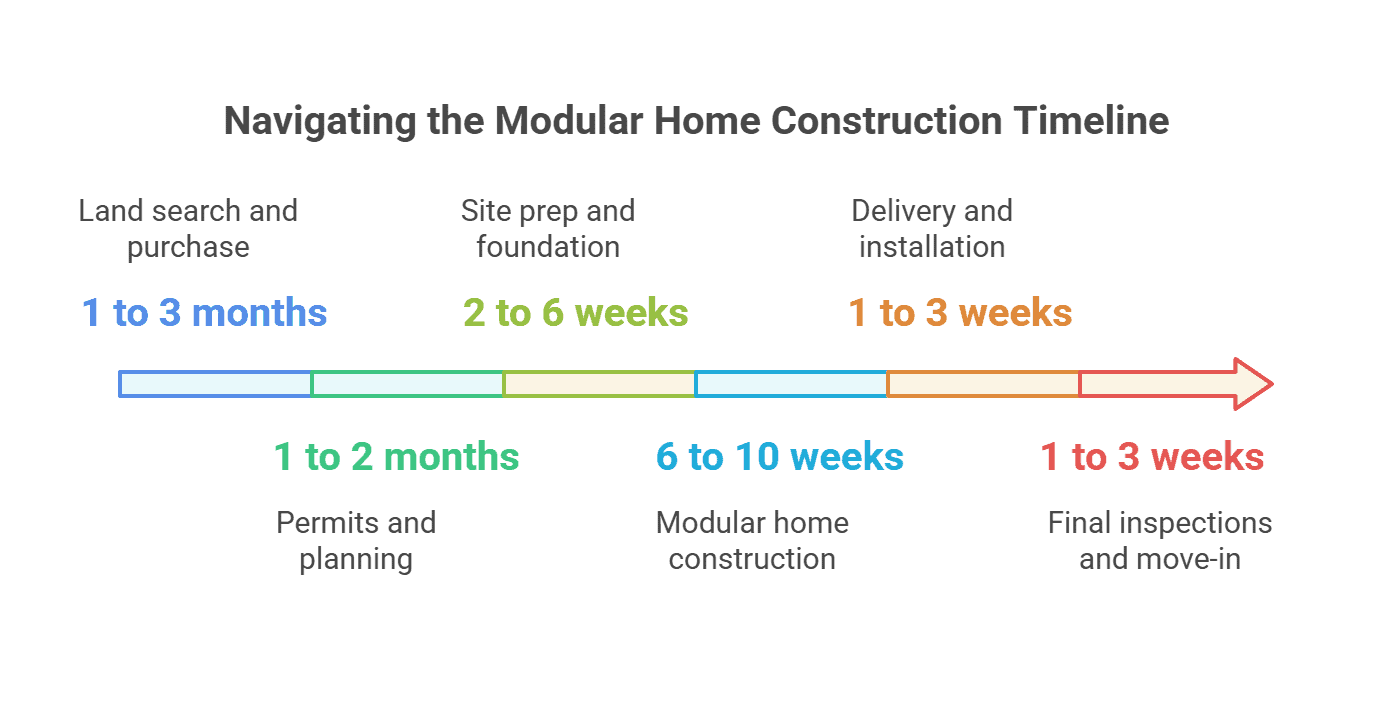
A continuación se muestra un desglose general de cada fase:
Búsqueda y compra de terrenos: 1 a 3 meses
Encontrar el terreno adecuado puede llevar tiempo, especialmente si tiene necesidades específicas de zonificación o servicios públicos. Si trabaja con un agente inmobiliario, el proceso puede ser más rápido, pero la diligencia debida (como la verificación del título de propiedad y los análisis de suelo) aún demora semanas.
Permisos y planificación: 1 a 2 meses
Una vez que el terreno sea suyo, solicitará los permisos de construcción, finalizará los diseños de la casa y contratará a los contratistas. Algunos condados aprueban los permisos en una semana; otros tardan de 4 a 6 semanas o más, especialmente durante la temporada alta.
Preparación del sitio y cimentación: de 2 a 6 semanas
El desmonte, la nivelación y los trabajos de cimentación suelen depender de la disponibilidad del contratista y del clima. La lluvia o el suelo congelado pueden retrasar este paso, especialmente en zonas rurales.
Construcción de casas modulares: 6 a 10 semanas (fuera del sitio)
Buenas noticias: esta parte se realiza mientras se prepara el terreno. Las casas modulares se construyen en una fábrica, generalmente en paralelo con el trabajo en la obra. Los plazos varían según el fabricante, pero es más rápido que la construcción tradicional.
Entrega e instalación: 1 a 3 semanas
La entrega, la instalación de la grúa, el montaje in situ y la conexión a los servicios públicos suelen ser rápidos, pero solo si su obra está realmente lista. En este caso, suelen producirse retrasos debido a problemas de acceso o inspección de última hora.
Inspecciones finales y mudanza: 1 a 3 semanas
Después de la instalación, necesitará inspecciones locales y un certificado de ocupación antes de poder mudarse. Algunos condados avanzan rápidamente; otros pueden requerir varias rondas de correcciones o nuevas verificaciones.
¿Quieres evitar retrasos? Haz estas tres cosas con antelación:
- Hable con su departamento de construcción local Antes de comprar un terreno
- Alinee a su constructor y contratista lo antes posible
- Solicitudes de permisos de inicio mientras finalizas el diseño de tu casa
Un proyecto de casa modular avanza más rápido que una construcción tradicional, pero aun así depende de una buena planificación. Si sabe qué esperar, podrá mantener un cronograma realista y reducir su nivel de estrés.
¿Quién puede ayudarle a gestionar el proceso?
No tiene que hacerlo todo usted mismo, y sinceramente, probablemente no debería hacerlo. Comprar el terreno, preparar el terreno, gestionar los permisos y coordinar la entrega requiere tiempo y experiencia. ¿La buena noticia? Hay profesionales que pueden guiarle en el proceso, o incluso encargarse de la mayor parte.
¿Hágalo usted mismo o listo para usar?
Algunos compradores optan por hacerlo ellos mismos. Buscan el terreno, contratan a los contratistas uno por uno y coordinan el proyecto ellos mismos. Si tiene el tiempo, los conocimientos y la paciencia necesarios, este enfoque puede ahorrarle dinero. Pero también significa... Eres responsable de cada parte móvil — y los errores pueden salir caros.
Otros van con un constructor modular llave en manoEstas empresas se encargan de todo: búsqueda de terrenos, permisos, diseño, cimentación, entrega, instalación e inspecciones finales. Usted sigue tomando decisiones clave, pero ellos gestionan la ejecución.
También hay un punto medio:
Usted compra el terreno y obtiene la financiación, y el constructor se encarga de la casa y las obras. Esto es común entre los compradores que desean cierto control, pero no quieren gestionar cada detalle.
Lo que un buen constructor modular puede hacer:
- Le ayudamos a evaluar si su terreno es edificable
- Ayudar con permisos y códigos locales.
- Coordinar la preparación del sitio y la cimentación
- Gestionar pedidos de fábrica, entregas e instalaciones.
- Conectar servicios públicos o recomendar profesionales locales
- Prepárese para las inspecciones y la aprobación final
Qué preguntar al elegir un constructor:
- ¿Ofrecen paquetes de terreno + casa?
- ¿Se encargan de gestionar permisos y trabajos en obra?
- ¿Puedo visitar otras casas que has construido?
- ¿Cuál es el cronograma promedio de su proyecto?
- ¿Trabajas con prestamistas locales?
Incluso si empiezas desde cero, no tienes que hacerlo solo. El socio adecuado puede ahorrarte meses de tiempo, miles de dólares en gastos evitables y muchísimo estrés. Empieza a preguntar con antelación. Los mejores constructores no solo te venderán una casa. Te ayudarán a construir tu plan.
Reflexiones finales: De un terreno vacío a un hogar verdaderamente suyo
Una vez que comprenda el proceso de compra de terreno, obtención de permisos y preparación para la instalación, comienza la verdadera emoción: elegir dónde y cómo vivirá. Hoy en día, las viviendas modulares no se limitan a un solo estilo ni ubicación.
Del creciente Comunidad de casas pequeñas en San Diego Escenario para la innovación casas modulares en Nueva York Los proyectos que están transformando la vida urbana amplían las opciones para los compradores que buscan algo flexible y moderno. comunidades modulares También están surgiendo en todo Estados Unidos nuevas tecnologías que combinan eficiencia con conexión con el vecindario.
En climas más cálidos, a los pioneros les gusta Constructores de casas contenedor en Florida están superando los límites con diseños sostenibles basados en acero. Y para muchas familias, la opción más significativa es construir una casa en un terreno familiar, convirtiendo la propiedad que ya posee en un legado a largo plazo.
Dondequiera que estés, la vida modular ofrece más que solo una casa: ofrece un camino hacia un estilo de vida que se adapta a tu visión, tu presupuesto y tu terreno.
¿Listo para dar el primer paso? Hablemos.
No necesitas el terreno, los permisos ni un constructor antes de contactarnos. Solo necesitas una visión y un socio que te ayude a hacerla realidad.
En Acero PRO PEB, diseñamos y fabricamos piezas de precisión casas modulares de acero, utilizando herramientas avanzadas como AutoCAD, Tekla Structures y 3DS MAX para brindarle diseños detallados en 2D y 3D, completamente gratis.
Cada estructura que entregamos está hecha de Acero de alta calidad que producimos internamenteCon total transparencia en el proceso, desde la materia prima hasta el acabado final. Tendrá acceso a imágenes, especificaciones y actualizaciones de producción en cada paso, sin conjeturas ni subcontratación.
Cuando llega el momento de construir, lo apoyamos con guías paso a paso, videos e incluso asistencia técnica in situ de nuestros ingenieros si es necesario.
Empieza tu proyecto con claridad. Diseñemos una casa modular que se adapte a tu terreno, presupuesto y visión, desde cero.
